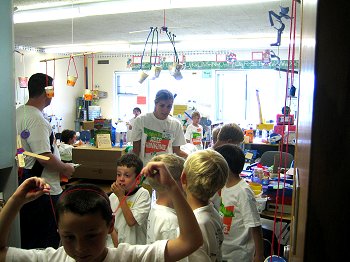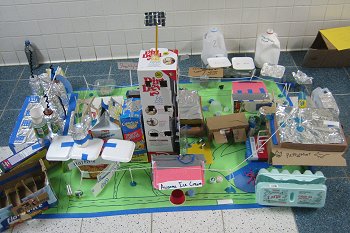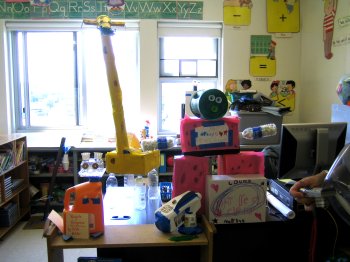- By Dan Veaner
- Around Town
 Print
Print
As last week progressed unusual inventions permeated Lansing Elementary School. A chocolate powered car helped stem pollution. Countless devices for suppressing annoying brothers and sisters were built from the remains of old computers, heaters, and other gadgets. The water in Sludge City became purer and clearer. A recycle kangaroo was devised to eat the garbage. And a trip to Mars required survival environments be developed.

Art Park
The 61 inventors were Lansing kids from first to sixth grade, and the program was Camp Invention. The program has been offered nationally since 1990 by the National Inventors Hall of Fame Foundation, based in Akron, Ohio. Last year more than 60,000 children in 48 states participated. Locally the program has been run for years by Lansing teacher Cathy Mosely. "I like watching the kids get excited about what they were doing," she says. "Watching them create and invent, change things... watching them think and learn."
That sentiment was echoed by all four teachers. Marilyn Farmer taught about pollution control in Sludge City, Lisa Peter guided young inventors as they took apart an old machine then used the parts to create a new one. Carrie Makela taught about Mars, encouraging new inventions for surviving on the red planet, and Ashley Hughes taught the Art Park module, mixing recycling with three-dimensional art. Campers attended each module once a day.

Space ships and Mars environments
In Sludge City campers were challenged by the children who lived there to clean up the landfill. The grownups had just dumped things behind their school and made a huge mess. The children learned about landfills and water filters, experimenting with the best ways to clean up the city, and finally designing their own cities.
"On Tuesday I told them a story about Sludge City and what happened to their water supply system and how people came to build, and farmers and fertilizer and pesticides..." Farmer says. "We kept adding to the water and it got goopier and goopier. I told them their job was to clean it."
Campers made the sludgy water with representations of pollutants, using potting soil for soil, Cool-aid for factory chemicals, and more until the water was a thick brown sludge. Each group designed a filtration system and experimented using gravel and sand, felt, cotton balls, coffee filters, and funnels.
"Two of the groups ended up with almost totally pure looking water," Farmer says. "They would filter it and it would still be pink. So I said 'try another filter,' and they filtered out the pink as well. I think they have an awareness that is especially timely with the Olympics right now. A lot of them have been watching in China, and we talked about the smog. I told them that China asked people not to drive, and it started to clean up the air."

Sludge City, cleaned up
Carrie Makaela's campers made space ships, living quarters, rovers and critters for their trip to Mars. "A lot of them got creative with their living space," Makaela says. "They had plasma TVs, refrigerators with lots of food. Their rockets came out really well, too. They made satellites and escape routes and solar panels."
Makaela says the kids knew a lot coming in because many of them had been through the space unit in second grade. "They love talking about Mars," she says. "I enjoy watching them create things, and come to new levels of thinking. A lot of them worked together as a group and decide what would be best for the group in their projects."
In Art Park campers focused on a different type of three-dimensional art each day, including totem poles, mobiles and moving art, and art made from recyclables. Thursday they were challenged to incorporate everything into their final piece. Kids were encouraged to make art with purpose and meaning that formed a concept inspiring the piece. Hughes says she thought animal creations that did recycling jobs were the most creative. "They have very inventive ideas," she says. "I am always surprised at how much they can come up with."
"There wasn't as much writing in this module, and there was no absolute end result," Hughes says. "So they could go anywhere with their ideas. It was nice to have that freedom in their work. They could be more creative, more expressive, and develop things on their own. That was the best thing."
A staple of Camp Invention is bringing in an old machine to transform into a new invention. They keep an inventor's log, posing a problem, then drawing an invention that will solve it. Finally they build the invention from the parts of an obsolete machine they have brought from home. As they work on their inventions they learn about other inventors' inventions, logos, copyright, and trademarks, and marketing.

Animals that eat grabage
"We have a bee house that traps bees and stops them from stinging, made out of an old space heater," Peter says. "We have a lot of things that are for taking care of annoying brothers and sisters: inventions that prevent them from entering bedrooms or just to stop them from teasing or bugging. We have something that takes pictures."
Counselors Brendan Hammond, Jess Esposito, Keelin Davis and Lindsey Oltz, each led an age group, taking them to activities and invention classes. Assistant Director Katie Bruon helped Moseley administer the program, and volunteers Ian Chan, Brittney Mikula, Kyle Vandepoel and Jen Wagner also helped.
"Children who attend Camp Invention learn skills that enhance their abilities to brainstorm, solve problems and work in teams," Moseley says. "It is known that children of all ages should continue sharpening these skills as we enter an era in which critical thinking will be extremely important to their future."
In addition children learned about recycling, battling pollution, and caring for our world. "I told them, 'You can do it'," Farmer told her campers. "'It's going to be your mission as an adult in this world to take care of your world.' It was a lot of fun. They did a nice job."
----
v4i32

Art Park
The 61 inventors were Lansing kids from first to sixth grade, and the program was Camp Invention. The program has been offered nationally since 1990 by the National Inventors Hall of Fame Foundation, based in Akron, Ohio. Last year more than 60,000 children in 48 states participated. Locally the program has been run for years by Lansing teacher Cathy Mosely. "I like watching the kids get excited about what they were doing," she says. "Watching them create and invent, change things... watching them think and learn."
That sentiment was echoed by all four teachers. Marilyn Farmer taught about pollution control in Sludge City, Lisa Peter guided young inventors as they took apart an old machine then used the parts to create a new one. Carrie Makela taught about Mars, encouraging new inventions for surviving on the red planet, and Ashley Hughes taught the Art Park module, mixing recycling with three-dimensional art. Campers attended each module once a day.

Space ships and Mars environments
In Sludge City campers were challenged by the children who lived there to clean up the landfill. The grownups had just dumped things behind their school and made a huge mess. The children learned about landfills and water filters, experimenting with the best ways to clean up the city, and finally designing their own cities.
"On Tuesday I told them a story about Sludge City and what happened to their water supply system and how people came to build, and farmers and fertilizer and pesticides..." Farmer says. "We kept adding to the water and it got goopier and goopier. I told them their job was to clean it."
Campers made the sludgy water with representations of pollutants, using potting soil for soil, Cool-aid for factory chemicals, and more until the water was a thick brown sludge. Each group designed a filtration system and experimented using gravel and sand, felt, cotton balls, coffee filters, and funnels.
"Two of the groups ended up with almost totally pure looking water," Farmer says. "They would filter it and it would still be pink. So I said 'try another filter,' and they filtered out the pink as well. I think they have an awareness that is especially timely with the Olympics right now. A lot of them have been watching in China, and we talked about the smog. I told them that China asked people not to drive, and it started to clean up the air."

Sludge City, cleaned up
Carrie Makaela's campers made space ships, living quarters, rovers and critters for their trip to Mars. "A lot of them got creative with their living space," Makaela says. "They had plasma TVs, refrigerators with lots of food. Their rockets came out really well, too. They made satellites and escape routes and solar panels."
Makaela says the kids knew a lot coming in because many of them had been through the space unit in second grade. "They love talking about Mars," she says. "I enjoy watching them create things, and come to new levels of thinking. A lot of them worked together as a group and decide what would be best for the group in their projects."
In Art Park campers focused on a different type of three-dimensional art each day, including totem poles, mobiles and moving art, and art made from recyclables. Thursday they were challenged to incorporate everything into their final piece. Kids were encouraged to make art with purpose and meaning that formed a concept inspiring the piece. Hughes says she thought animal creations that did recycling jobs were the most creative. "They have very inventive ideas," she says. "I am always surprised at how much they can come up with."
"There wasn't as much writing in this module, and there was no absolute end result," Hughes says. "So they could go anywhere with their ideas. It was nice to have that freedom in their work. They could be more creative, more expressive, and develop things on their own. That was the best thing."
A staple of Camp Invention is bringing in an old machine to transform into a new invention. They keep an inventor's log, posing a problem, then drawing an invention that will solve it. Finally they build the invention from the parts of an obsolete machine they have brought from home. As they work on their inventions they learn about other inventors' inventions, logos, copyright, and trademarks, and marketing.

Animals that eat grabage
"We have a bee house that traps bees and stops them from stinging, made out of an old space heater," Peter says. "We have a lot of things that are for taking care of annoying brothers and sisters: inventions that prevent them from entering bedrooms or just to stop them from teasing or bugging. We have something that takes pictures."
Counselors Brendan Hammond, Jess Esposito, Keelin Davis and Lindsey Oltz, each led an age group, taking them to activities and invention classes. Assistant Director Katie Bruon helped Moseley administer the program, and volunteers Ian Chan, Brittney Mikula, Kyle Vandepoel and Jen Wagner also helped.
"Children who attend Camp Invention learn skills that enhance their abilities to brainstorm, solve problems and work in teams," Moseley says. "It is known that children of all ages should continue sharpening these skills as we enter an era in which critical thinking will be extremely important to their future."
In addition children learned about recycling, battling pollution, and caring for our world. "I told them, 'You can do it'," Farmer told her campers. "'It's going to be your mission as an adult in this world to take care of your world.' It was a lot of fun. They did a nice job."
----
v4i32



